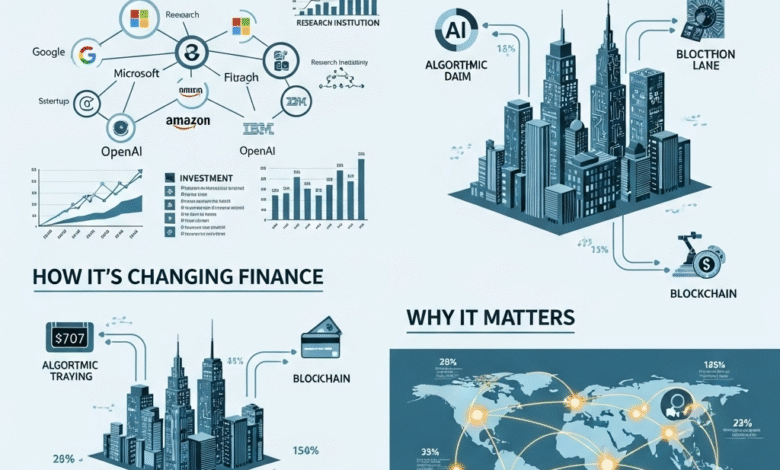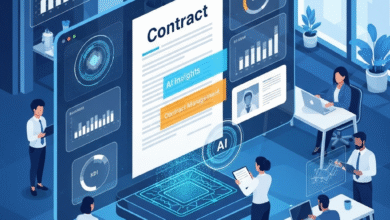The AI Landscape
Who's Building It, How It's Changing Finance, & Why It Matters

The AI Landscape : Who’s Building It, How It’s Changing Finance, & Why It Matters
Artificial Intelligence isn’t just science fiction anymore; it’s the engine driving innovation across virtually every industry. From streamlining your online shopping recommendations to revolutionizing how we diagnose diseases and manage financial risk, AI is here. But navigating this rapidly evolving field can be daunting. Who are the key players? How is it being used in critical areas like finance? And what does this powerful technology actually cost? Let’s dive into the fascinating world of AI companies and their transformative impact.
The Titans and Trailblazers: What Companies Make Artificial Intelligence & Who’s Leading?
The AI ecosystem is vast and layered. It’s not just about one type of company. We can categorize them into several key groups, answering both “what companies make artificial intelligence” and “what companies are leading in artificial intelligence”:
-
The Tech Behemoths (Cloud & Platform Providers): These giants invest billions in foundational AI research and provide the essential cloud platforms and tools that enable countless other companies to build and deploy AI. They are undeniably leading in artificial intelligence:
-
Google (Alphabet): DeepMind (pioneering AlphaFold for protein folding, AlphaGo), Google AI, TensorFlow framework, Gemini AI models, AI integrated across Search, Maps, Gmail, Ads, and Google Cloud AI services.
-
Microsoft: Massive investment in OpenAI (ChatGPT, DALL-E), Azure AI platform (Cognitive Services, Machine Learning), GitHub Copilot, AI deeply embedded in Microsoft 365 (Copilot), Dynamics 365, and LinkedIn.
-
Amazon Web Services (AWS): SageMaker (machine learning platform), Bedrock (foundation models), Rekognition (image/video analysis), Lex (chatbots), Kendra (intelligent search), and AI powering Amazon’s logistics and recommendations.
-
Meta (Facebook): PyTorch framework (widely used in research), massive investments in generative AI (Llama large language models), AI for content recommendation, ad targeting, and content moderation across Facebook, Instagram, and WhatsApp.
-
IBM: A long history in AI, Watson platform (especially strong in enterprise AI, NLP, and industries like healthcare and finance), Red Hat OpenShift for AI workloads.
-
-
Pure-Play AI Powerhouses (Research & Model Development): These companies focus intensely on pushing the boundaries of AI capabilities, often developing the cutting-edge models others build upon. They are crucial to what companies are developing artificial intelligence:
-
OpenAI: Creator of ChatGPT, GPT models, DALL-E, and Sora. Initially research-focused, now a major commercial player partnered with Microsoft.
-
Anthropic: Focused on developing safe, reliable, and steerable AI systems (Claude models), emphasizing AI alignment research.
-
Cohere: Specializes in large language models (LLMs) tailored for enterprise use cases, focusing on security and customization.
-
Hugging Face: The central hub for open-source AI models, datasets, and collaboration (the “GitHub of AI”). While not primarily a model creator, they enable massive development.
-
-
Enterprise AI Specialists (Applied Solutions): These companies take foundational AI and build specialized applications for specific business problems across industries. They directly answer “what companies make artificial intelligence” solutions:
-
C3.ai: Provides enterprise AI software suites for predictive maintenance, fraud detection, supply chain optimization, and energy management.
-
Palantir: Known for data integration and analytics platforms (Gotham, Foundry) heavily utilizing AI for government and large enterprise use cases (defense, intelligence, supply chain).
-
UiPath/Automation Anywhere/Blue Prism: Leaders in Robotic Process Automation (RPA), increasingly incorporating AI (Computer Vision, NLP) for Intelligent Automation (IA).
-
DataRobot/AWS SageMaker/Azure ML: Platforms focused on automating the machine learning lifecycle, making AI development faster and more accessible.
-
NVIDIA: While primarily a hardware company (their GPUs are the engine for AI training), CUDA software and platforms like Omniverse position them as key enablers. Their advancements directly fuel what other companies can develop.
-
-
AI-First Startups (Niche Innovators): Thousands of agile startups are developing artificial intelligence for incredibly specific applications, from drug discovery (e.g., Recursion Pharmaceuticals, Insilico Medicine) to creative tools (e.g., Midjourney, Runway ML) to climate modeling and cybersecurity. This is where much bleeding-edge innovation happens.
Listed Artificial Intelligence Companies: Many of the companies mentioned above are publicly traded, offering investors exposure to the AI boom. Key examples include:
-
Tech Giants: Alphabet (GOOGL), Microsoft (MSFT), Amazon (AMZN), Meta (META), NVIDIA (NVDA), IBM (IBM)
-
Enterprise Players: Palantir (PLTR), C3.ai (AI), UiPath (PATH)
-
Hardware: NVIDIA (NVDA), AMD (AMD), Intel (INTC) – crucial for AI infrastructure.
The AI Revolution in Finance: Loan and Insurance Underwriting Transformed
Two critical areas seeing massive AI disruption are credit lending and insurance. Let’s explore how artificial intelligence loan underwriting and artificial intelligence insurance underwriting are changing the game:
-
AI-Powered Loan Underwriting:
-
Beyond Traditional Credit Scores: AI models can analyze vast, alternative data sources (bank transaction history, cash flow patterns, rental payment history, even anonymized utility payments or business platform data) to assess creditworthiness, especially for “thin-file” borrowers.
-
Faster Decisions & Reduced Bias: Automation streamlines document processing and data extraction. AI can potentially reduce human bias in decision-making if models are carefully designed and audited for fairness.
-
Dynamic Risk Pricing: Models can continuously learn and adjust risk assessments based on new data, allowing for more personalized loan terms.
-
Fraud Detection: AI excels at spotting subtle patterns indicative of fraudulent loan applications.
-
Companies Leading Here: Fintechs like Upstart, Affirm, Kabbage (now part of American Express), Zest AI, and traditional banks increasingly integrating AI into their systems via platforms like FICO, Experian, or custom solutions.
-
-
AI-Powered Insurance Underwriting:
-
Personalized Risk Assessment: AI analyzes diverse data points beyond traditional demographics and claims history – IoT data (smart homes, wearables), satellite imagery (property condition), social listening (for business risk), driving behavior telematics – to create hyper-personalized risk profiles and premiums.
-
Automation & Efficiency: Streamlining data collection, processing applications, and generating initial quotes significantly speeds up the underwriting process.
-
Predictive Analytics: Models predict future claims likelihood more accurately based on complex patterns, leading to better risk selection and pricing.
-
New Product Development: AI enables insurers to create usage-based insurance (UBI) products (like pay-per-mile auto insurance) and micro-insurance tailored to specific, short-term needs.
-
Companies Leading Here: Insurtechs like Lemonade, Hippo, Root Insurance, established giants like Lemonade, Progressive (Snapshot), Allstate (Drivewise), and specialized AI providers like Shift Technology (focusing on fraud and claims) or Tractable (computer vision for damage assessment).
-
The Immense Scale: How Many Companies Use AI & How Many Exist?
Quantifying the AI landscape is challenging due to its rapid evolution and varying definitions, but the numbers are staggering:
-
How many AI companies are there? Estimates vary widely. Some sources suggest tens of thousands globally, encompassing everything from massive tech firms to tiny niche startups developing specific AI algorithms or applications. Platforms like Crunchbase list over 50,000 companies tagged with “Artificial Intelligence.” This explosion directly answers “what companies are developing artificial intelligence” – it’s a vast and diverse field.
-
How many companies use artificial intelligence? Adoption is skyrocketing:
-
Surveys consistently show a majority of medium and large enterprises are either experimenting with, piloting, or actively deploying AI. A recent McKinsey Global Survey found over 50% of companies report adopting AI in at least one business function.
-
Adoption varies by industry (Tech, Finance, Healthcare leading) and company size (larger firms generally adopt faster due to resources).
-
The number is constantly increasing as AI tools become more accessible (via cloud platforms) and proven ROI becomes clearer. It’s safe to say millions of businesses globally utilize some form of AI, even if just basic chatbots or analytics tools.
-
How Much Does the Power Cost? Demystifying Artificial Intelligence Pricing
“How much does artificial intelligence cost?” is like asking how much a house costs. The range is enormous and depends entirely on:
-
Type of AI Solution:
-
Off-the-Shelf SaaS Tools: (e.g., ChatGPT Plus, Midjourney subscriptions, pre-built analytics dashboards): $10 – $100s per user/month.
-
API-Based Services: (e.g., using Google Vision API, OpenAI API, AWS Transcribe): Pay-per-use, often fractions of a cent per transaction (image analyzed, text generated, minute transcribed). Costs scale with volume.
-
Custom AI Development: Building bespoke models or applications. This is the most expensive, ranging from tens of thousands to millions of dollars. Factors include:
-
Data acquisition/preparation costs.
-
Complexity of the problem and model architecture.
-
Expertise required (data scientists, ML engineers – high salaries).
-
Cloud computing resources for training (GPU time is costly).
-
Ongoing maintenance, monitoring, and retraining.
-
-
Enterprise AI Platforms: (e.g., DataRobot, C3.ai): Often involve significant annual licensing fees ($100,000+), plus implementation and customization costs.
-
-
Implementation & Integration: Costs to connect AI with existing systems (ERP, CRM) and ensure data flows securely.
-
Data Costs: Acquiring, cleaning, labeling, and storing high-quality data can be a major expense.
-
Ongoing Costs: Maintenance, monitoring model performance, retraining models as data drifts, cloud hosting fees, and personnel costs.
The Big Picture: Why This All Matters
The sheer number of companies making, leading in, and using artificial intelligence, coupled with its transformative applications in critical areas like loan underwriting and insurance underwriting, underscores a fundamental shift. AI is not a niche technology; it’s becoming the bedrock of modern business operations and innovation.
Understanding the landscape – the key players (what companies are leading in artificial intelligence), the scale (how many AI companies are there, how many companies use artificial intelligence), and the practicalities like cost (how much does artificial intelligence cost) – is crucial for:
-
Businesses: To stay competitive, identify partners/vendors, understand risks (bias, ethics), and make informed investment decisions.
-
Professionals: To identify career opportunities and necessary skills.
-
Consumers: To understand how decisions about loans, insurance, and services are increasingly being made and advocate for fairness and transparency.
-
Investors: To navigate the listed artificial intelligence companies and broader market.
The Future is Intelligent
The question is no longer if AI will impact an industry, but how and how quickly. The companies developing artificial intelligence today are shaping the tools and systems that will define tomorrow’s economy and society. From the artificial intelligence loan underwriting accelerating access to capital, to the artificial intelligence insurance underwriting creating fairer premiums, the applications are profound. As costs continue to evolve and accessibility increases, the number of companies using artificial intelligence will only grow. Staying informed about this dynamic landscape is key to navigating and thriving in the intelligent future ahead.





